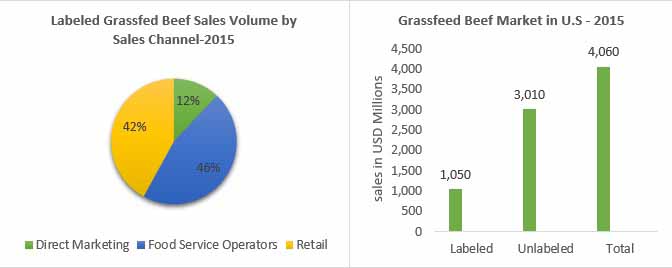Grassfed Meat Market Dynamics, Forecast, Analysis and Supply Demand 2018-2028Posted by vakhas on August 1st, 2019 Grassfed Meat Market Players to Utilize Sales Channels Effectively Grassfed meat is sold across various sales channels, predominantly in local stores. The local grocer with sales throughout the New Zealand, mentioned the significant rise in the sales of grassfed meat, particularly grassfed beef since they began selling it a year ago. The company to increase the sales of grassfed meat such as beef to cater to the increasing demand for grassfed meat, grassfed meat in particular. Grassfed meat market players are also moving towards other retail channels to accelerate the grassfed meat business. The grassfed meat market players are going beyond the conventional ways of distributing the product amongst the customers. The local as well as online sale of grassfed meat is significantly contributing to the increasing sales revenue as the product is available on a larger platform for the customers. Amazon has also previously expressed its strategies of expanding the distribution of grassfed meat along with organic meat. For the same purpose, Amazon visited White Oak Pastures in the year 2017, for discussing the distribution deal. These activities are highlighting the approach adopted by companies to increase the sales of grassfed meat. Grassfed meat market players are therefore utilizing the most effective sales channels for business. Grassfed Meat: Market Outlook The recent decade has resulted into an increase in global production and consumption of meat. Consumption of meat in different regions of the world is linked to various factors such as standard of living, production of livestock in the particular region, recent trends and other market dynamics going on in the market. Recent trends in the global meat market such as new flavors, breed branding, innovative product types and religious preferences are influencing the consumers buying behavior. Among the different types of meat, quality is of utmost importance when it comes to red meat. Most of the health-conscious consumers opt for organic and Grass-fed labels while choosing red meat products. Grassfed meat isn’t the same as the organic meat, however, it is a possibility that a meat product can be labeled both organic and grass-fed. Grassfed in simple language means animals reared and raised 100% only on grass as the feed. Request Free Sample Report@ https://www.factmr.com/connectus/sample?flag=S&rep_id=655 Grassfed Meat Market: Reasons for Covering this Title Grassfed meat and meat products are emerging as one of the super foods, and as a healthier alternative to grain fed meat. The major difference is that grassfed meat products are much lower in fat content as compared to the grain fed meat products. In fact, researchers claim that grassfed meat provides with more or less with the same amount of fat that a chicken or a deer meat would provide. The Grassfed meat is one of the best lean meat options available currently in the market. A grassfed label is dominantly applied for the meat of cow, and it can also be applied for Bison, Goat, and lambs. Grassfed meat has higher nutrient content of linoleic acid (CLA), antioxidants and vitamins. Grassfed meat is less likely to contain any kind of “Superbugs” hence making it a better choice of meat from food safety perspective. Grassfed provides around six times more “omega-3 fatty acids” Out of all the fats these are the most beneficial for heart health. In order to provide the consumers with above-mentioned benefits of grassfed meat, meat processors and farmers are offering new product variants to the consumers. Global Grassfed Meat: Market Segmentation On the basis of nature, the global Grassfed meat market has been segmented as –
On the basis of Animal Type, the global Grassfed meat market has been segmented as –
On the basis of distribution channel, the global Grassfed Meat market has been segmented as –
On the basis of product type, the global Grassfed Meat market has been segmented as –
Exhibit 1 Fat content by Meat and Meat product Type Global Grassfed Meat Market: Key Players Some of the key players operating in the global Grassfed Meat market are JBS Global, AUSTRALIAN AGRICULTURAL COMPANY LIMITED, Creekstone and Nolan Ryan’s, Omaha Steaks, Allen Brothers, Meyer Natural Food, Maverick Ranch, Cargill Inc., Teys Australia, Sysco Corp, Australian Organic Meats Group Pty Ltd, Eversfield Organic Ltd., Hormel Foods Corporation, PRE Brands, LLC, Panorama Meats, Verde Farms and others. Following illustration shows the advantages of consuming grassfed meat provided by the above mentioned companies over the Grainfed/grass finished meat. Exhibit 2 Grassfed Beef V/S Grainfed Beef
Launching new product variants, acquiring the smaller players in the market generating awareness about the benefits of Grassfed Meat products through various promotional activities and programs are some of the key drivers supporting the market growth in the near future. Key Developments
 Opportunities for Market Participants Grassfed meat market is expected to show an exponential growth in North American region in next few year as, the average American, ate around 65 pounds of beef and around quarter pound of Bison in 2010. There is a lot of scope for the growth of the grassfed Bison meat market. Catering the growing demand for products containing several health benefits is one of the key supply-side driver supporting the market growth. Right kind of land assets, animal genetics and proper management skills, around the different regions in the world, may provide opportunities for investment in grassfed meat production. The grassfed meat market is expected to show an exponential growth in the North American region in next few year as, the average American, ate around 65 pounds of beef and around a quarter pound of Bison in 2010. There is a lot of scope for the growth of the grassfed Bison meat market. Catering the growing demand for products containing several health benefits is one of the key supply-side driver supporting the market growth. Right kind of land assets, animal genetics, and proper management skills, around the different regions in the world, may provide opportunities for investment in grassfed meat production. Brief Approach to Research A modelling-based approach and triangulation methodology will be followed to estimate data covered in this report. A detailed market understanding and assessment of the applications, types, forms and end uses of the product segments covered in the study is followed by carrying out a demand-side approach to estimate the sales of target product segments, which is then cross-referenced with a supply-side assessment of value generated over a pre-defined period. The statistics and data is collected at a regional level, consolidated and synthesized at a global level to estimate the overall market sizes. Key Data Points Covered in the Report Some of the key data points covered in our report include:
This analytical research study imparts an all-inclusive assessment on the market, while propounding historical intelligence, actionable insights, and industry-validated & statistically-upheld market forecast. Verified and suitable set of assumptions and methodology has been leveraged for developing this comprehensive study. Information and analysis on key market segments incorporated in the report has been delivered in weighted chapters. A thorough analysis has been offered by the report on
Regional Segments Analyzed Include
Compilation of authentic and first-hand intelligence, insights offered in the report are based on quantitative and qualitative assessment by leading industry experts, and inputs from opinion leaders & industry participants around the value chain. Growth determinants, macroeconomic indicators, and parent market trends have been scrutinized and delivered, coupled with the market attractiveness for each market segment encompassed. Qualitative impact of growth influencers on the market segments across regions has also been mapped by the report. Highlights from the Report
Like it? Share it!More by this author |


